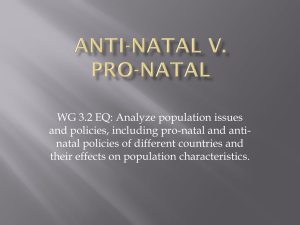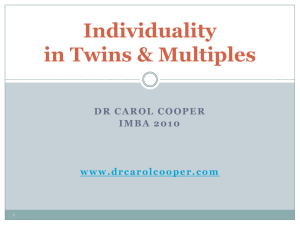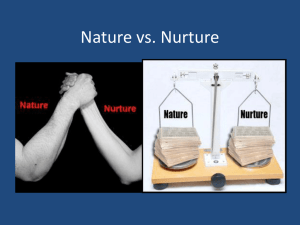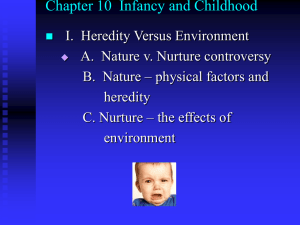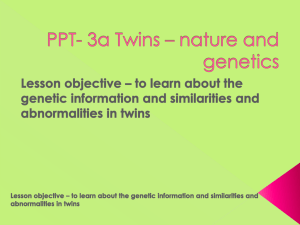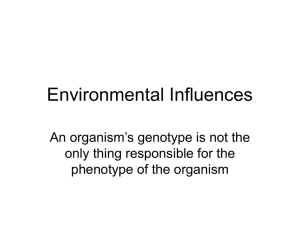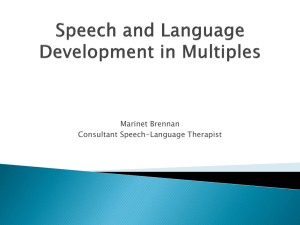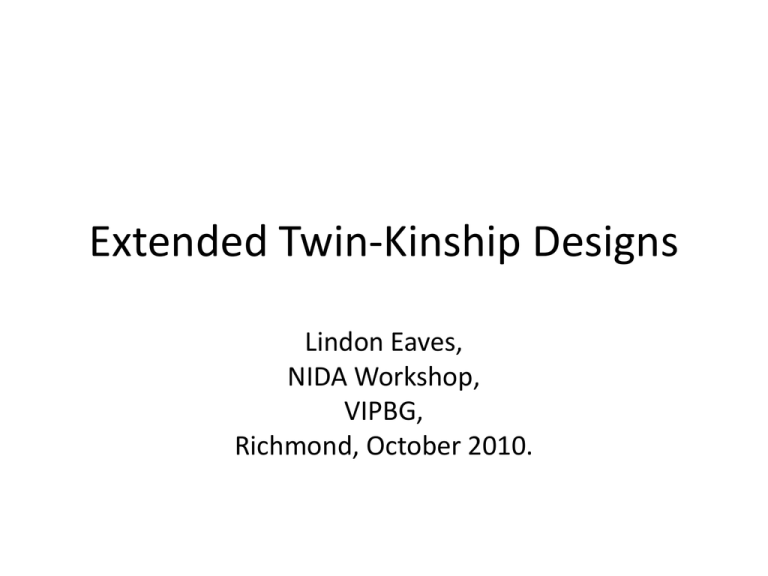
Extended Twin-Kinship Designs
Lindon Eaves,
NIDA Workshop,
VIPBG,
Richmond, October 2010.
Some issues
• Human = DNA x Brains x Feet x World
• People live in families and society
“Environment” matters as much as “Genes”
• Focus on ideas
• Illustrate with real world applications
• No “one-size-fits-all”: design and model
depends on question and context
The Extended Phenotype
Parents
World
Me
Spouse
Siblings
Child
Extended Phenotype
Nuclear Families
Non-Genetic Inheritance
Genetic Inheritance
Nuclear Families
•
•
•
•
“Typical”
Common (large samples)
Test for spousal resemblance
Biological and cultural transmission
confounded
• Age/secular differences between generations
Classical Twin Design
• Easy to get large samples
• Matched for age
• Gives preliminary estimates of major
components (“A,C,E”)
• Test for sibling interaction/imitation/contrast
• Test for interaction with covariates
• Easy Extension to multivariate/longitudinal
case
Limitations of Twin Study
• Focus on phenotype of individual twin (ignores
“extended phenotype”)
• Twins may be “special”
• Matched for age (no rest for Gx Age interaction, in
cross-sectional data)
• No generally applicable test of “D” (non-additive
genetic effects) in presence of ACE.
• Can’t fit A,C, E and “D” at same time. Estimates of ACE
biased by “D”.
• “C” is a mixture of effects (“real” shared environment,
“passive rGE”, effects of parental assortative mating)
Extensions of the Twin Study
•
•
•
•
•
•
Twins and Siblings (“TAS”)
Twins and Parents (“TAP”)
Children of Twins (“COT”)
Spouses of Twins (“SPOT”)
All of the above (“E-Twin”)
Longitudinal extensions (e.g. “L-TAP”)
Twins and Siblings
MZ
DZ
Twins and Siblings: Test Assumptions
1.
2.
3.
4.
Compare means of twins and sibs
Compare DZ and Sib correlations
Test for and analyze birth order effects
Test for interaction of sib-resemblance with
age
5. Add parents?
“TAP”: Twins and Parents
MZ
DZ
Combining Twins and Nuclear
Families
Familial Transmission in the US and
Australia
Eaves, Hatemi, Heath and Martin (2010, in press) in
Hatemi and McDermott “Man is a Political Animal”.
Univ. Chicago Press
Twins, Parents of Twins, Nuclear Families
Parents of Twins
Siblings of Twins
Spouses of Twins
Twins
Offspring of Twins
© Lindon Eaves, 2009
Twins and Parents
• Resolve biological and cultural transmission if
measure same phenotype in both generations
• Include some analysis of assortment
• Some test for non-additive effects
(dominance, GxAge)
• Some test of child-parent interaction
(evocative rGE)
• “Easy to do” especially with juveniles. Lots of
ways of using. But need to be careful.
The Virginia 30,000
Twins
Parents of Twins
Spouses of Twins
Children of Twins
Siblings of Twins
Other
Total
Men
5325
913
2515
1890
1260
67
Women
9436
1447
1876
2910
1924
128
Total
14781
2360
4391
4800
3184
195
11970
17721
29691
The Australia 22,000
Twins
Parents of Twins
Spouses of Twins
Children of Twins
Siblings of Twins
Men
3459
1418
1547
925
1554
Women
6098
1956
823
668
2032
Total
9557
3374
2370
1593
3586
Total
8646
11834
20480
Sample Sizes (Number of Pairs of Relatives) for Participating Families.
Note: variation occurs in the number of pairs for different variables because of patterns of missing variables.
For the purposes of this analysis values are assumed to be missing at random.
Sample Sizes (N pairs)
Relationship
Spouses
MotherDaughter
Mother-Son
FatherDaughter
Father-Son
Par.-Offspring
Male siblings
Female
siblings
Male-Female
siblings
Siblings
Male
DZ
twins
Female DZ
twins
Male-Female
DZ twins
DZ Twins
Male
MZ
twins
Female MZ
twins
MZ Twins
Min
4525
3994
Virginia
Max
4930
4667
Max
3474
4291
Australia
Median
3422
4208
Total
Median
8287
8875
Median
4865
4549
Min
2569
2882
2724
2675
3138
3095
3045
3010
2001
2009
2948
3005
2861
2947
5906
5957
1962
2247
2174
12778
1552
2859
2224
12240
4398
25018
1368
3203
1551
3645
1523
3588
1105
2139
1586
3288
1540
3228
3063
6816
3858
4395
4331
3131
4562
4487
8818
505
583
9442
575
285
476
9255
380
18697
955
1022
1183
1151
624
955
826
1977
1147
1334
1310
629
1070
878
2188
721
790
3036
774
482
723
2084
632
5120
1406
1657
1885
1843
1032
1469
1374
3217
2006
4623
2617
Nuclear Family Correlations for Stature
(Virginia 30,000 and OZ 22,000)
0.5
0.45
0.4
0.35
0.3
0.25
0.2
0.15
0.1
0.05
0
US
Australia
© Lindon Eaves, 2009
Nuclear Family Correlations for Stature and Liberalism/Conservatism
(Virginia 30,000)
0.7
0.6
0.5
0.4
0.3
0.2
Stature
Liberalism
0.1
0
© Lindon Eaves, 2009
Nuclear Family Correlations for Liberalism/Conservatism
(Virginia 30,000 and Australia 22,000)
0.8
0.7
0.6
0.5
0.4
0.3
0.2
0.1
0
US
Australia
© Lindon Eaves, 2009
Nuclear Family Correlations for Stature and EPQ Neuroticism
(Virginia 30,000)
0.5
0.45
0.4
0.35
0.3
0.25
0.2
0.15
0.1
0.05
0
Stature
Neuroticism
© Lindon Eaves, 2009
Nuclear Family Correlations for Socially Significant Variables
(Virginia 30,000)
0.8
0.7
0.6
0.5
0.4
0.3
0.2
0.1
0
Political Pref.
Church At.
Education
Neuroticism
© Lindon Eaves, 2009
Nuclear Family Correlations for Socially Significant Variables
(Australia 22K)
0.9
0.8
0.7
0.6
0.5
0.4
0.3
0.2
0.1
0
Political Pref.
Church At.
Education
Neuroticism
© Lindon Eaves, 2009
Twin Correlations for Stature
(Virginia 30,000 and Australia 22,000)
1
0.9
0.8
0.7
0.6
0.5
0.4
0.3
0.2
0.1
0
US
Australia
DZM
DZF
DZMF
MZM
MZF
© Lindon Eaves, 2009
Twin Correlations for Stature and Liberalism
(Virginia 30,000 and Australia 22,000)
1
0.9
0.8
0.7
0.6
0.5
0.4
0.3
0.2
0.1
0
Stature US
Stature OZ
Liberal US
Liberal OZ
DZM
DZF
DZMF
MZM
MZF
© Lindon Eaves, 2009
Twin Correlations for Socially Significant Variables
(Virginia 30,000)
1
0.9
0.8
0.7
0.6
0.5
0.4
0.3
0.2
0.1
0
Political Pref.
Church At.
Education
Neuroticism
DZM
DZF
DZMF MZM
MZF
©
Lindon Eaves,
2009
Twin Correlations for Socially Significant Variables
(Australia 22,000)
0.9
0.8
0.7
0.6
Political Pref.
0.5
Church At.
0.4
Education
0.3
Neuroticism
0.2
0.1
0
DZM
DZF
DZMF MZM
MZF
© Lindon Eaves, 2009
Expected correlations between twins and nuclear families:
Model for joint biological and cultural inheritance
Relationship
Expected Correlation
Spouses
m
Mother-Daughter
vf + muf + ½ hf(HF+mHm)
Mother-Son
vm + mum + ½ hm(HF+mHm)
Father-Daughter
uf + mvf + ½ hf(Hm+mHf)
Father-Son
um + mvm + ½ hm(Hm+mHf)
Male siblings
ghm2 + um2 + vm2 + 2mumvm + hm[vm(Hf + mHm ) + um(Hm+mHf )] + cm2
Female siblings
ghf2 + uf2 + vf2 + 2mufvf + hf [vf(Hf + mHm ) + uf(Hm+mHf )] + cf2
Male-Female siblings
ghmhf + umuf + vmvf + m(ufvm+ umvf) + ½hm [vf(Hf + mHm ) + uf(Hm+mHf )] +
½hf [vm(Hf + mHm ) + um(Hm+mHf )] + cm cf
Male DZ
ghm2 + um2 + vm2 + 2mumvm + hm[vm(Hf + mHm ) + um(Hm+mHf )] + cm2+ tm2
Female DZ
ghf2 +
Male-Female DZ
ghmhf + umuf + vmvf + m(ufvm+ umvf) + ½hm [vf(Hf + mHm ) + uf(Hm+mHf )] +
½hf [vm(Hf + mHm ) + um(Hm+mHf )] + cm cf + tm tf
Male MZ
hm2 + um2 + vm2 + 2mumvm + hm[vm(Hf + mHm ) + um(Hm+mHf )] + cm2 + tm2
Female MZ
hf 2 +
Where:
g = ½ (1+mHmHf)
Subject to:
1-hm2 + um2 + vm2 + 2mumvm + hm[vm(Hf + mHm ) + um(Hm+mHf )] + cm2 + tm2 +em2 = 0
1-hf2 +
uf2 + vf2 + 2mufvf +
uf2 + vf2 + 2mufvf +
uf2 + vf2 + 2mufvf +
hf [vf(Hf + mHm ) + uf(Hm+mHf )] + cf2 + tf 2
hf [vf(Hf + mHm ) + uf(Hm+mHf )] + cf2+ tf 2
hf [vf(Hf + mHm ) + uf(Hm+mHf )] + cf2+ tf 2+ef2= 0
H’m - hm + ½Hm(vm + mum) + ½Hf(um + mvm) = 0
H’f - hf + ½Hm(vm + mum) + ½Hf(um + mvm) = 0
Note: The model tabulated does not incorporate genetic dominance, GxAge interaction
or sex-specific genetic and environmental effects.
Twins, Parents and Nuclear Families:
Proportions (%) of variance in phenotype
attributed to sources in best-fitting model.
Stature
US
Au
VA
72.8
68.3
Conserve’m
US
Au
44.8
48.6
Neuroticism
US
Au
23.1
28.7
Church
Attendance
US
Au
63.5
43.4
Political
Affiliation
US
Au
Educational
Attainment
US
Au
59.4
34.0
VD
11.9
16.2
VE
15.3
15.4
43.2
36.5
11.0
5.6
Males
VEC
VET
4.7
9.3
7.2
5.7
VCI
VA
76.7
76.2
56.5
55.8
65.9
65.7
29.5
26.6
26.1
44.8
2.1
1.5
8.9
6.5
51.8
21.9
19.2
2.5
10.5
17.6
14.5
32.5
14.3
18.3
11.8
15.2
VD
14.9
5.7
62.1
49.0
18.5
58.1
58.4
40.7
Females
VE
VEC
14.4
18.1
36.7
28.9
11.8
14.7
VET
3.5
10.9
3.3
4.4
27.1
36.0
6.1
6.8
4.8
8.3
46.4
28.8
10.9
0.0
20.0
16.3
14.1
26.9
18.3
22.7
9.2
9.7
VCI
58.7
58.7
20.7
54.9
Sources of variance:
VA =Additive genetic;
VD = Dominance genetic ;
VE = Residual, unique environmental, within sibships;
VEC = Residual shared environmental among sibships; VET = Additional shared environmental between twin pairs;
VCI = Non-genetic (“cultural”) inheritance from parental phenotype.
Summary
• Results consistent across (western) samples –
except for political affiliation
• Most parent-offspring transmission genetic after
allowance for assortment – except for political
affiliation
• Not much shared environment – except for
education and political affiliation
• Consistently different patterns of transmission for
different variables – assortment much more
important for “social” variables
Spouses of Twins
Unraveling the Process of Mate
Selection
Classical Treatment (Fisher, 1918)
• Considered:
1. Assortment based on measured phenotype
2. Assortment for “essential genotype”
3. Assortment for correlated trait
Twins and Spouses
Parents of Twins
Siblings of Twins
Spouses of Twins
Twins
Offspring of Twins
© Lindon Eaves, 2009
Spousal Resemblance Based on Assortative Mating for Measured Phenotype
Spousal Resemblance Based on Assortative Mating for Phenotype Measured with Error
Assortment for a latent correlated variable (e.g. “social homogamy”)
Spousal Interaction
See: Heath AC (1987) Acta Genetica Medica et Gemellelogiae
Goodness-of-fit statistics
(weighted residual sums of squares, S2)
for selected models for assortative mating in the US and Australia
Model
d.f.
Sample
Random
mating
Phenotypic
(P)
P+Error
Spousal
Interaction
Social
Homogamy
14
S2
11
S2
16
S2
15
S2
13
S2
449.179
239.827
2535.373
2041.407
63.371
28.337
3375.872
3019.544
2213.625
2337.500
2477.957
1430.440
31.363
12.947
14.845
31.627
17.811
17.444
15.187
22.140
22.254
34.183
46.210
44.146
24.4231
11.8171
12.143
29.669
See note2
See note2
12.841
21.5481
18.500
32.537
28.207
18.624
Variable
Stature
US
AU
Conservatism US
AU
Neuroticism
US
AU
Church
US
attendance
AU
Political
US
affiliation
AU
Educational
US
attainment
AU
78.930
31.694
118.266
113.276
20.226
15.583
103.042
76.574
87.889
70.696
243.100
160.747
28.786
25.353
328.491
239.123
19.458
22.807
611.006
403.950
429.819
322.685
57.774
82.086
Notes:
regression of male outcome on latent trait on upper bound (1.000).
2This model is poorly identified for Neuroticism because the correlation between mates is close to zero.
1Estimated
Twins and Parents
Twins and Parents
• Combine benefits of twin study and nuclear
families
• Twins help separate genes and environment
• Parents allow test for and some analysis of
assortative mating
• Parent-offspring data test some models for
intergenerational transmission
• Test for evocative rGE if assess parenting
towards individual twins
Example
Parental Anti-Social Personality and
Juvenile Conduct Disorder:
A Longitudinal Study of Twins and Parents
Eaves et al. (2010) Behavior Genetics
Observe
• Parental neglect correlates with child conduct
disorder (CD)
• Parental ASP correlates with juvenile CD
• ASP parents tend to neglect their children
Question
• Does parental neglect cause child CD OR is the
association a secondary consequence of:
• a) the fact that parental neglect is a
“symptom” of ASP
• b) the fact that parental ASP shares a
common familial (genetic?) association with
juvenile CD?
To Answer the Question we need to:
• Sort out the genetics of adult ASP
• Sort out the genetics of juvenile CD
• Sort out the genetic and environmental
relationships between adult and juvenile ASP and
CD within and between generations
• Deal with spousal resemblance
• Model sex differences in transmission and effects
of genes and environment
• Resolve direct causal effect (DCE) of neglect from
secondary genetic association with juvenile CD
Design
• Twins and Parents: Parents measured as
Adults (ASP and Neglect of Children)
• Same twins measured as juveniles (CD) and
young adults (ASP)
Polychoric correlations between childhood adversity and anti-social behavior of adult and juvenile offspring.
Outcome
Adult male
Adult female
Juvenile male
Juvenile female
Statistic
r
0.1506
0.2986
0.2276
0.3183
N
476
513
364
406
a.s.e.
0.0770
0.0659
0.1045
0.0824
Polychoric correlations between parental (adult) anti-social behavior (ASP) and childhood adversity
Relationship
Mother-Father ASP
Father ASP-Adversity
Mother ASP.-Adversity
Statistic
r
0.4006
0.2805
0.4121
N
942
489
577
a.s.e.
0.0370
0.0707
0.0565
Polychoric correlations between anti-social behavior of (adult) parents and
adult (ASP) and juvenile (CD) anti-social behavior of their offspring.
Statistic
Relationship
Mother-adult son
Mother-adult daughter
Mother-juvenile son
Mother-juvenile
daughter
Father-adult son
Father-adult daughter
Father-juvenile son
Father-juvenile
daughter
N
977
1158
662
746
r
0.2368
0.2126
0.1475
0.2454
a.s.e.
0.0398
0.0380
0.0583
0.0558
761
869
525
568
0.1507
0.2558
0.2035
0.1450
0.0471
0.0442
0.0671
0.0681
Polychoric correlations for juvenile conduct disorder and
adult anti-social personality in YAFU/VTSABD twins.
Statistic
Relationship
Twins
(as adults)
Twins
(as juveniles)
Twins
(adult-juvenile)
Within subject
(adult-juvenile)
MZm
MZf
DZm
DZf
DZmf
MZm
MZf
DZm
DZf
DZmf
MZm
MZf
DZm
DZf
DZmf
DZfm
Males
Females
N
243
333
137
154
209
169
225
101
92
132
288
394
168
164
115
113
569
674
r
0.5654
0.5093
0.2646
0.4069
0.3069
0.8003
0.8023
0.5153
0.4189
0.0150
0.1751
0.1126
0.1526
0.3596
0.0595
0.0647
0.2452
0.1103
a.s.e.
0.0615
0.0611
0.1078
0.0960
0.0875
0.0572
0.0552
0.1498
0.1565
0.1809
0.0879
0.0848
0.1284
0.1101
0.1474
0.1630
0.0632
0.0643
Conceptual model for the effects of genes and the family environment on anti-social behavior.
Estimated contributions of parents and residual
effects to the shared environment of twin offspring.
Effects of the unique and shared environment
on adult and juvenile anti-social behavior and females.
Estimated passive genotype-environment correlations and
sibling correlations between additive genetic components
assuming equilibrium under assortative mating and non-genetic parent-child transmission.
Second sibling
Component
First
Sibling
GAF
GJF
GAM
GJM
GAF
0.5033
0.0000
0.0406
0.0000
0.0683
GJF
0.0000
0.5000
0.0000
0.0000
0.0000
GAM
0.0406
0.0000
0.5082
0.0000
0.0101
GAF
0.0000
0.0000
0.0025
0.5000
0.0000
Note: Under random mating, the diagonal genetic
correlations are expected to be 0.5 and the offdiagonals zero.
In the absence of either genetic or non-genetic
transmission the genotype-environment
correlations (the last column in the table) are
expected to be zero.
rGE
The Children of Twins (“COT”)
Effects of Maternal and Fetal
Genotype on Preterm Birth
York et al. (2010) PLoS-One
Children of Twins
Parents of Twins
Siblings of Twins
Spouses of Twins
Twins
Offspring of Twins
© Lindon Eaves, 2009
Varieties of COT
•
•
•
•
“MZ-half siblings” (Corey and Nance, 1974)
Children of MZ and DZ twins
Twins and the children of twins
Children of Twins and children of siblings
Children of twins
• Resolve effects of maternal/paternal and fetal
genotype (care!!)
• Resolve genetic from environmental effects of
parents on children (with parents)
• Need to be careful: assortative mating and
home environment dyadic (depends on both
parents)
Virginia Preterm Birth Study
Sample frequencies by parental relationship
and race
European American
Parental
relationship
Sibship
Maternal half-sibship
Paternal half-sibship
MZ male twin
MZ female twin
DZ male twin
DZ female twin
DZ male-female twin
Total
African American
N. Families
N. Births
N. Families
N. Births
284,446
6,736
5,419
595
618
393
368
936
299,511
575,709
12,269
9,800
1,092
1,212
700
696
1,614
603,092
66,983
2,431
2,839
69
98
52
72
139
72,683
119,791
4,515
5,292
99
144
77
119
210
130,247
Source: York, TP et al (2010). Racial Differences in Genetic and Environmental Risk to
Preterm Birth. PLoS One: 5(1), 1-6, e12391.
Estimated variance components from Virginia Preterm Birth Study
Full Genetic Model (Model 2)
Source
Reduced Genetic Model (Model 12)
Estimate
95% CI
Percentage
Estimate
95% CI
Percentage
Fetal genetic
0.264
(0.0, 2.302)
3.7
-
-
-
Maternal genetic
0.976
(0.274, 1.357)
13.8
1.040
(0.531, 1.445)
14.7
Shared environment
1.215
(0.499, 1.666)
17.1
1.281
(0.872, 1.781)
18.0
Unique environment
4.642
(3.559, 4.899)
65.4
4.777
(4.625, 4.927)
67.3
Fetal genetic
1.325
(0.640, 1.927)
35.2
1.325
(0.695, 1.964)
35.2
Maternal genetic
0.503
(0.263, 0.767)
13.4
0.503
(0.235, 0.758)
13.4
Shared environment
0.263
(0.006, 0.537)
7.0
0.264
(0.027, 0.537)
7.0
Unique environment
1.673
(1.355, 2.024)
44.4
1.674
(1.355, 1.990)
44.5
African American
European American
95% bootstrap confidence intervals.
Estimates adjusted for covariates (birth order, maternal age, fetal sex, source of care, smoking, maternal education).
Source: York, TP et al (2010). Racial Differences in Genetic and Environmental Risk to
Preterm Birth. PLoS One: 5(1), 1-6, e12391.
Genetic and environmental influences on the
transmission of parental depression to
children’s depression and conduct disturbance
Notes
Uncorrelated residual environmental effects on children are omitted from the figure.
Key to symbols:T1=Twin 1; T2=Twin 2; S1=Spouse of Twin 1; S2=Spouse of Twin 2; O1=Offspring of Twin 1; O2=Offspring of Twin 2;
A= additive genetic effects expressed in both adults and children (“life course persistent”);
A’ = residual additive genetic effects specific to children (“juvenile limited”);
C = shared environmental effects adults; C’= shared environmental effects on children explained by parental phenotype;
C”= residual, juvenile specific, shared environmental effects in twins and siblings.
E=adult unique environmental effect
Source: Eaves, Maes and Silberg (2010), JCCP.
Twin, parent - child, avuncular – offspring, and cousin correlations for MZ and DZ twins.
Twin correlations
MZ adult 1
DZ adult 1
MZ child 2
DZ child 2
Adult - Child correlations 3
MZ parent
DZ parent
MZ avuncular
DZ avuncular
Cousin Correlations
MZ twin pair families
DZ twin pair families
1Adult
2 Juvenile
Depression*
.32 (n=498)
.12 (n=545)
.34 (n=692)
.17 (n=645)
Conduct Disturbance**
.18 (n=753)
.20 (n=845)
.07 (n=661)
.01 (n=654)
.21 (n=1347)
.23 (n=1508)
.11 (n=1141)
.06 (n=1129)
.01 (n=261)
.02 (n=185)
.15 (n=526)
.15 (n=441)
.73 (n=684)
.34 (n=627)
twin correlations - Children of Twins Study (COT)
twin correlations - Virginia Twin Study of Adolescent Behavioral Development (VTSABD)
3 Complete and incomplete twin pair families
* Child ratings of depression
** Parental ratings of conduct
Summary of Model-Fitting Results for Adult Depression and Juvenile Outcome in Children of Twins
Parameter
Correlation between spouses
Persistent additive genetic effect to adult phenotype
Persistent additive genetic effect to juvenile phenotype
Juvenile-limited genetic effect to juvenile phenotype
Adult shared environment to adult phenotype
Parental phenotype to juvenile shared environment
Juvenile shared environment to juvenile phenotype
Juvenile-specific shared environment to phenotype
Correlation between persistent genetic and shared environmental effects
Free?
F
F
F
F
F
D
F
F
D
Depression Conduct
0.1761
0.2064
0.5410
0.5426
0.0000!
0.3898
0.5339
0.6775
0.0000!
0.0000!
0.6520
0.6438
0.2101
0.1304
0.0000!
0.0000!
0.4149
0.4215
Partial regression of juvenile outcome on parental phenotype
D
0.1369
0.0839
Correlation between genes of parents and phenotype of parents
D
0.5410
0.5246
Correlation between additive genetic effects of siblings/twins
-2lnL
K
c2
d.f.
P
D
0.5226
7116.827
4
0.325
3
0.9552
0.5304
3916.157
5
1.218
2
0.5438
Notes: K= # of free (unconstrained) parameters in the model. F=free; D=derived
!=parameter fixed at zero ex hypothesi; “Comparison” denotes model with which reduced model is compared;
c2=log-likelihood ratio chi-square for model comparison; d.f. = degrees of freedom for c2;
The Full Monty….
ANZUS 50K: Extended Kinships of Twins
Parents of Twins
Siblings of Twins
Spouses of Twins
Twins
Offspring of Twins
© Lindon Eaves, 2009
The Full Monty
Genes
• Additive
• Assortment
• Dominant
Environment
• Parents
• Siblings
• Twins
• Within-family
• Short-term
Any or all of the above effects may depend on sex
It can get complicated
Caveat emptor
The First Model: “Stealth”
s
r
u
q
A
1
s
v
e
r
u
q
B
C
A
v
e
B
C
1
L
L
1
lf
K
af
kf
1
i
PF
tm
T
am bm cm
cf
.5
.5
.5 .5
.5
m
q*
u*
A
q*
C
A
y
am bm cm
L
TM
tm
u*
B
af
L
cf
1 lf
T
km 1
K
T
w
d
tf
1
K
kf
TF
e
C
1
lm 1
T
o
e
B
1
tf
.5
pn
1
Truett et al.,
1994.
.5
K
km
PM
.5
1
lm
Sample sizes for in the Virginia 30,000
# of pairs
0
2000
4000
6000
8000
10000
12000
14000
Relationship
MZ
DZ
Sib
Parent
MZ Avunc
Avunc
MZ cousin
Cousin
Spouse
MZ-in-law
Sib-in-law
Par-in-law
MZ spouse
DZ spouse
MZ ad unc
adop unc
# of pairs
Correlations
for Stature
in theinVirginia
30,000
Summary Correlations
for Stature
the Virginia
30,000
Correlation
Relationship0
0.1
0.2
0.3
0.4
0.5
0.6
0.7
0.8
0.9
MZ
DZ
Sib
Parent
MZ Avunc
Avunc
MZ cousin
Cousin
Spouse
MZ-in-law
Sib-in-law
Par-in-law
MZ spouse
DZ spouse
MZ ad unc
adop unc
Stature
Relative Contributions to Stature Differences
0%
6%
14%
0%
14%
H
AM
D
VCI
S
U
G-E
14%
52%
Summary Correlations for Church Attendance in the Virginia 30,000
Correlation
Relationship0
0.1
0.2
0.3
0.4
0.5
0.6
0.7
0.8
MZ
DZ
Sib
Parent
MZ Avunc
Avunc
MZ cousin
Cousin
Spouse
MZ-in-law
Sib-in-law
Par-in-law
MZ spouse
DZ spouse
MZ ad unc
adop unc
Ch. Att.
Summary Correlations for Stature and Church Attendance in the Virginia
30,000
Correlation
Relationship0
0.1
0.2
0.3
0.4
0.5
0.6
0.7
0.8
0.9
MZ
DZ
Sib
Parent
MZ Avunc
Avunc
MZ cousin
Stature
Cousin
Ch. Att,
Spouse
MZ-in-law
Sib-in-law
Par-in-law
MZ spouse
DZ spouse
MZ ad unc
adop unc
Conservatism: Components of Variation
21.5
13.8
36.5
11.3 0.8 9.5
6.8
H
AM
Women
D
VCI
S
U
G-E
-8.7
37.2
23.9
5.51.6
0.1
40.4
Men
-20%
0%
20%
40%
60%
80%
100%
Summary Correlations for Conservatism in the Virginia 30,000
Correlation
Relationship0
0.1
0.2
0.3
0.4
0.5
0.6
0.7
MZ
DZ
Sib
Parent
MZ Avunc
Avunc
MZ cousin
Cousin
Spouse
MZ-in-law
Sib-in-law
Par-in-law
MZ spouse
DZ spouse
MZ ad unc
adop unc
Conser'm
Summary Correlations for Stature and Conservatism in the Virginia
30,000
Correlation
Relationship0
0.1
0.2
0.3
0.4
0.5
0.6
0.7
0.8
0.9
MZ
DZ
Sib
Parent
MZ Avunc
Avunc
MZ cousin
Cousin
Spouse
MZ-in-law
Sib-in-law
Par-in-law
MZ spouse
DZ spouse
MZ ad unc
adop unc
Conser'm
Stature
Church Attendance: Components of Variation
Women
14
4.2
11.8
4.4
40.9
15.7
9
H
AM
D
VCI
S
U
G-E
Men
14.5
0%
10%
4.4 3.3 3
20%
50.5
16.9
30%
40%
50%
60%
70%
7.5
80%
90%
100%
Overview of Statistical Findings
•
•
•
•
•
Measures differ in effects of G and E
Environmental effects on attitudes etc much larger than on stature
Men and women differ significantly for size of G and E
Biggest environmental effects not shared by siblings
Family environment largest for religious and political affiliation much smaller for “religious control” and church attendance
• Genetic effects largest on aggregate conservatism and on liberalism
and “religious control” clusters
• Large spousal correlations
• Some negative gene-environment correlation
• Developmental change in effects of genes and shared environment

